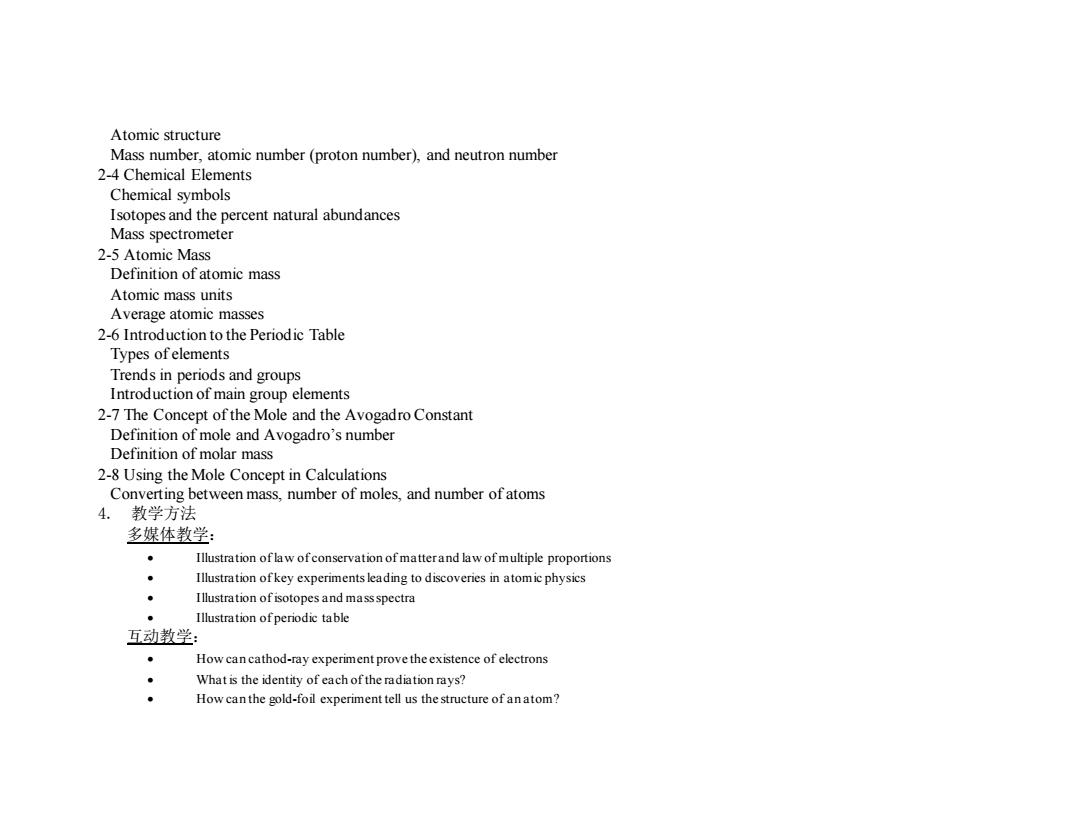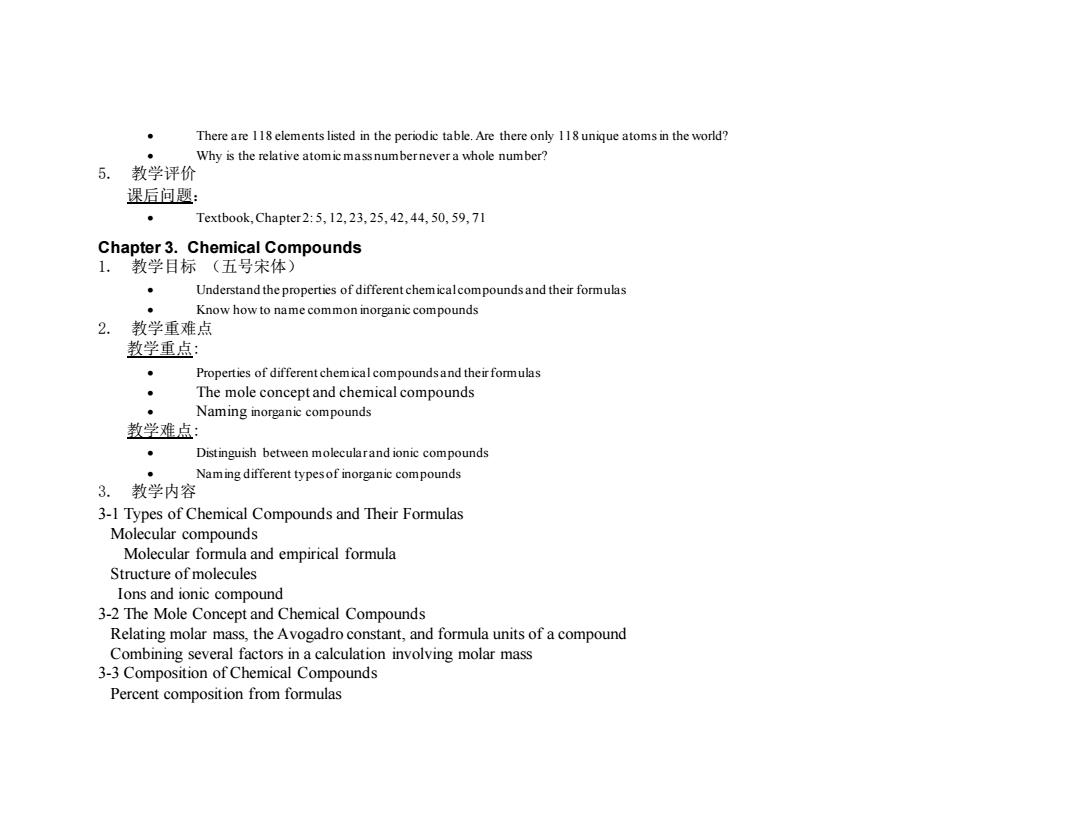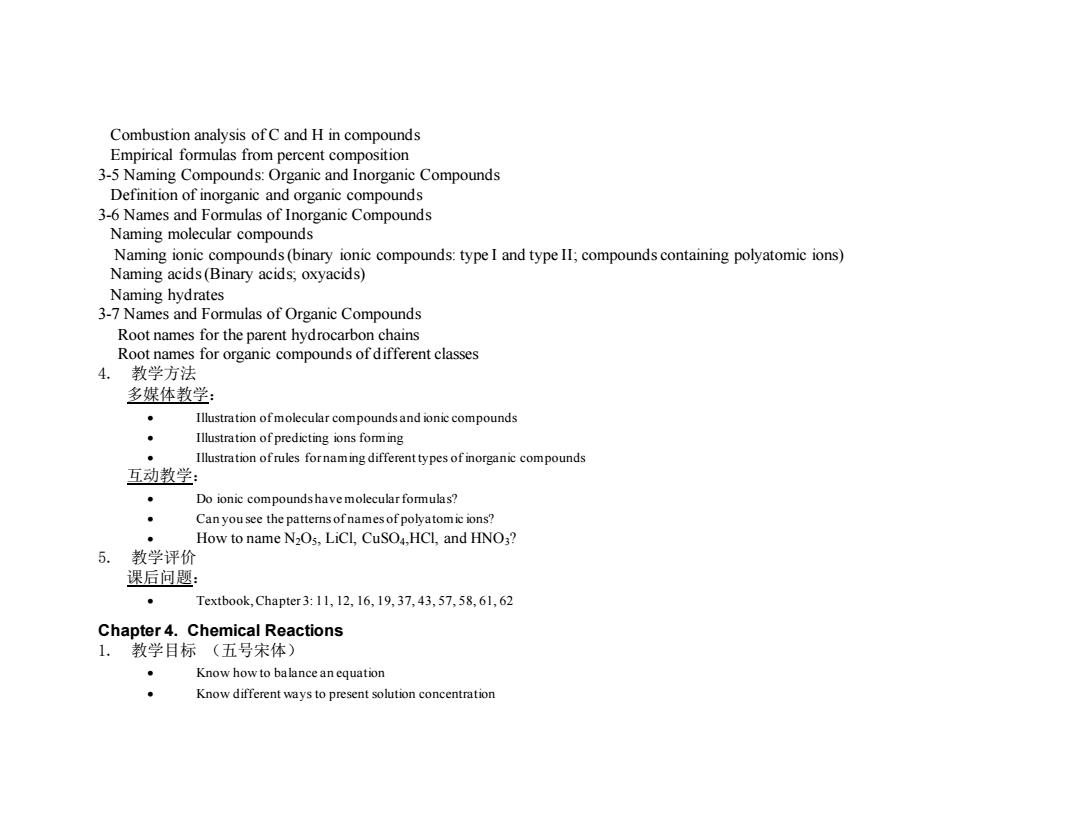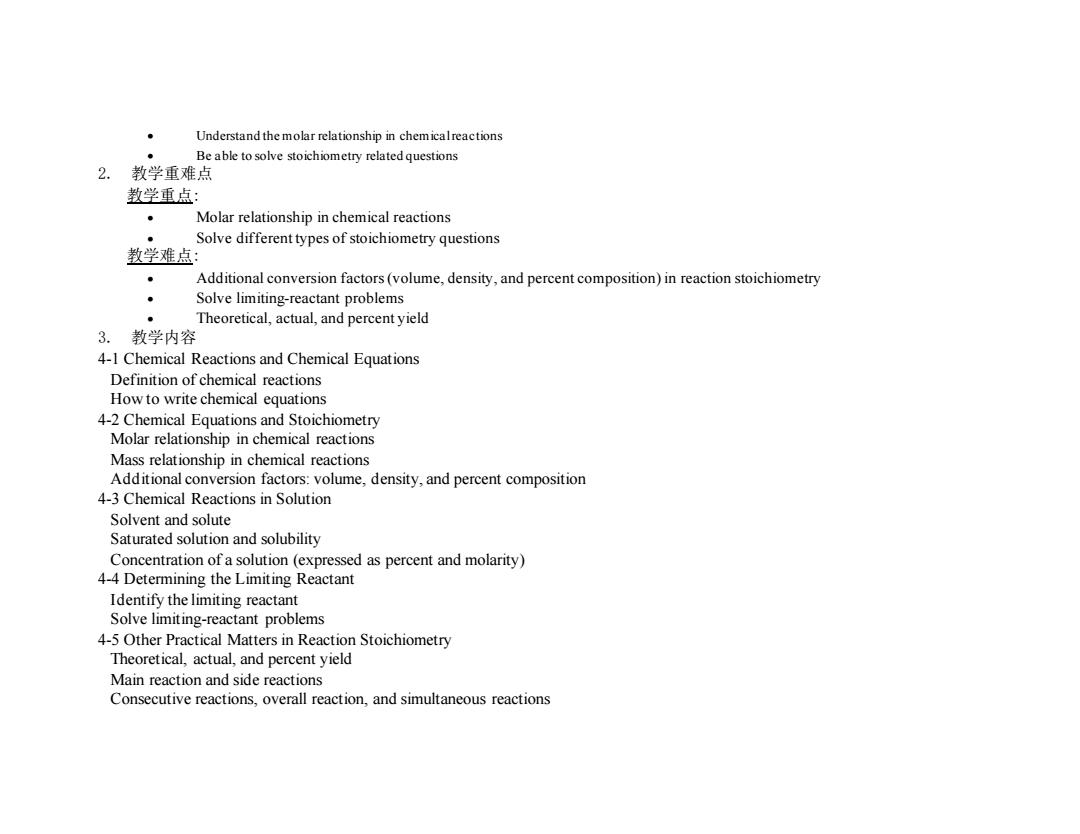
Textbook,Chapter1:7,10,12,23,31,32,54,61,69,89 Chapter 2.Atoms and the Atomic Theory 1.教学目标 Understand the structure of atoms Understand the general properties ofatoms Get a genera idea about the periodic table Understand the meaning of molar mass 2.教学重难点 教学重点: The historical path leading to identification of atom ic structure Mass number,atomic number,neutron number,and atomic mass of an atom Trends in periods and groups Definition of mole and Avogadro's number 教学难点 Experiments leading to discovery of electrons and nucleus Converting between mass,number of moles,and number of atoms 3.教学内容 2-1 Early Chemical Discoveries and the Atomic Theory Law of conservation of matter Law of constant composition John Dalton's atomic theory Law of multiple proportions 2-2 Electrons and Other Discoveries in Atomic Physics Thomson's cathode-ray experiment and Thomson's model of the atom Millikan's oil drop experiment and determination of the charge and mass of the electron 2-3 The Nuclear Atom Rutherford's gold foil experiment and Rutherford's model of the atom Discovery of protons Discovery of neutrons
• Textbook, Chapter 1: 7, 10, 12, 23, 31, 32, 54, 61, 69, 89 Chapter 2. Atoms and the Atomic Theory 1. 教学目标 • Understand the structure of atoms • Understand the general properties of atoms • Get a genera idea about the periodic table • Understand the meaning of molar mass 2. 教学重难点 教学重点: • The historical path leading to identification of atomic structure • Mass number, atomic number, neutron number, and atomic mass of an atom • Trends in periods and groups • Definition of mole and Avogadro’s number 教学难点: • Experiments leading to discovery of electrons and nucleus • Converting between mass, number of moles, and number of atoms 3. 教学内容 2-1 Early Chemical Discoveries and the Atomic Theory Law of conservation of matter Law of constant composition John Dalton’s atomic theory Law of multiple proportions 2-2 Electrons and Other Discoveries in Atomic Physics Thomson’s cathode-ray experiment and Thomson’s model of the atom Millikan’s oil drop experiment and determination of the charge and mass of the electron 2-3 The Nuclear Atom Rutherford’s gold foil experiment and Rutherford’s model of the atom Discovery of protons Discovery of neutrons

Atomic structure Mass number,atomic number(proton number),and neutron number 2-4 Chemical Elements Chemical symbols Isotopes and the percent natural abundances Mass spectrometer 2-5 Atomic Mass Definition of atomic mass Atomic mass units Average atomic masses 2-6 Introduction to the Periodic Table Types ofelements Trends in periods and groups Introduction of main group elements 2-7 The Concept of the Mole and the Avogadro Constant Definition of mole and Avogadro's number Definition of molar mass 2-8 Using the Mole Concept in Calculations Converting between mass,number of moles,and number of atoms 4. 教学方法 多媒体教学: Illustration of law of conservation of matterand law of multiple proportions Illustration ofkey experiments leading to discoveries in atomic physics Illustration ofisotopes and massspectra Illustration ofperiodic table 互动教学: How can cathod-ray experiment prove the existence of electrons What is the identity of each of the radiation rays? How can the gold-foil experiment tell us the structure of anatom?
Atomic structure Mass number, atomic number (proton number), and neutron number 2-4 Chemical Elements Chemical symbols Isotopes and the percent natural abundances Mass spectrometer 2-5 Atomic Mass Definition of atomic mass Atomic mass units Average atomic masses 2-6 Introduction to the Periodic Table Types of elements Trends in periods and groups Introduction of main group elements 2-7 The Concept of the Mole and the Avogadro Constant Definition of mole and Avogadro’s number Definition of molar mass 2-8 Using the Mole Concept in Calculations Converting between mass, number of moles, and number of atoms 4. 教学方法 多媒体教学: • Illustration of law of conservation of matter and law of multiple proportions • Illustration of key experiments leading to discoveries in atomic physics • Illustration of isotopes and mass spectra • Illustration of periodic table 互动教学: • How can cathod-ray experiment prove the existence of electrons • What is the identity of each of the radiation rays? • How can the gold-foil experiment tell us the structure of an atom?

There are 118 elements listed in the periodic table.Are there only 118 unique atoms in the world? Why is the relative atomic massnumbernever a whole number? 5. 教学评价 课后问题: Textbook,Chapter2:5,12,23.25,42,44,50,59,71 Chapter 3.Chemical Compounds 1.教学目标(五号宋体) Understand the properties of different chemicalcompounds and their formulas Know how to name common inorganic compounds 2. 教学重难点 教学重点: Properties of different chemical compoundsand their formulas The mole concept and chemical compounds Naming inorganic compounds 教学难点: Distinguish between molecularand ionic compounds Naming different types of inorganic compounds 3.教学内容 3-1 Types of Chemical Compounds and Their Formulas Molecular compounds Molecular formula and empirical formula Structure of molecules Ions and ionic compound 3-2 The Mole Concept and Chemical Compounds Relating molar mass,the Avogadro constant,and formula units of a compound Combining several factors in a calculation involving molar mass 3-3 Composition of Chemical Compounds Percent composition from formulas
• There are 118 elements listed in the periodic table. Are there only 118 unique atoms in the world? • Why is the relative atomic mass number never a whole number? 5. 教学评价 课后问题: • Textbook, Chapter 2: 5, 12, 23, 25, 42, 44, 50, 59, 71 Chapter 3. Chemical Compounds 1. 教学目标 (五号宋体) • Understand the properties of different chemical compounds and their formulas • Know how to name common inorganic compounds 2. 教学重难点 教学重点: • Properties of different chemical compounds and their formulas • The mole concept and chemical compounds • Naming inorganic compounds 教学难点: • Distinguish between molecular and ionic compounds • Naming different types of inorganic compounds 3. 教学内容 3-1 Types of Chemical Compounds and Their Formulas Molecular compounds Molecular formula and empirical formula Structure of molecules Ions and ionic compound 3-2 The Mole Concept and Chemical Compounds Relating molar mass, the Avogadro constant, and formula units of a compound Combining several factors in a calculation involving molar mass 3-3 Composition of Chemical Compounds Percent composition from formulas

Combustion analysis of C and H in compounds Empirical formulas from percent composition 3-5 Naming Compounds:Organic and Inorganic Compounds Definition of inorganic and organic compounds 3-6 Names and Formulas of Inorganic Compounds Naming molecular compounds Naming ionic compounds(binary ionic compounds:type I and type II;compounds containing polyatomic ions) Naming acids(Binary acids;oxyacids) Naming hydrates 3-7 Names and Formulas of Organic Compounds Root names for the parent hydrocarbon chains Root names for organic compounds of different classes 4.教学方法 多媒体教学: Illustration ofmolecular compounds and ionic compounds Illustration of predicting ions forming ● Illustration ofrules fornaming different types of inorganic compounds 互动教学 Do ionic compounds have molecular formulas? Can you see the patterns ofnames of polyatomic ions? How to name N2Os,LiCl,CuSO4,HCL,and HNO3? 5.教学评价 课后问题: Textbook,Chapter.3:11,12,16,19,37,43,57,58,61,62 Chapter 4.Chemical Reactions 1.教学目标(五号宋体) Know how to balance an equation Know different ways to present solution concentration
Combustion analysis of C and H in compounds Empirical formulas from percent composition 3-5 Naming Compounds: Organic and Inorganic Compounds Definition of inorganic and organic compounds 3-6 Names and Formulas of Inorganic Compounds Naming molecular compounds Naming ionic compounds (binary ionic compounds: type I and type II; compounds containing polyatomic ions) Naming acids (Binary acids; oxyacids) Naming hydrates 3-7 Names and Formulas of Organic Compounds Root names for the parent hydrocarbon chains Root names for organic compounds of different classes 4. 教学方法 多媒体教学: • Illustration of molecular compounds and ionic compounds • Illustration of predicting ions forming • Illustration of rules for naming different types of inorganic compounds 互动教学: • Do ionic compounds have molecular formulas? • Can you see the patterns of names of polyatomic ions? • How to name N2O5, LiCl, CuSO4,HCl, and HNO3? 5. 教学评价 课后问题: • Textbook, Chapter 3: 11, 12, 16, 19, 37, 43, 57, 58, 61, 62 Chapter 4. Chemical Reactions 1. 教学目标 (五号宋体) • Know how to balance an equation • Know different ways to present solution concentration

Understand the molar relationship in chemicalreactions Be able to solve stoichiometry related questions 2. 教学重难点 教学重点: Molar relationship in chemical reactions Solve different types of stoichiometry questions 教学难点: Additional conversion factors(volume,density,and percent composition)in reaction stoichiometry Solve limiting-reactant problems Theoretical,actual,and percent yield 3.教学内容 4-1 Chemical Reactions and Chemical Equations Definition of chemical reactions How to write chemical equations 4-2 Chemical Equations and Stoichiometry Molar relationship in chemical reactions Mass relationship in chemical reactions Additional conversion factors:volume,density,and percent composition 4-3 Chemical Reactions in Solution Solvent and solute Saturated solution and solubility Concentration of a solution(expressed as percent and molarity) 4-4 Determining the Limiting Reactant Identify the limiting reactant Solve limiting-reactant problems 4-5 Other Practical Matters in Reaction Stoichiometry Theoretical,actual,and percent yield Main reaction and side reactions Consecutive reactions,overall reaction,and simultaneous reactions
• Understand the molar relationship in chemical reactions • Be able to solve stoichiometry related questions 2. 教学重难点 教学重点: • Molar relationship in chemical reactions • Solve different types of stoichiometry questions 教学难点: • Additional conversion factors (volume, density, and percent composition) in reaction stoichiometry • Solve limiting-reactant problems • Theoretical, actual, and percent yield 3. 教学内容 4-1 Chemical Reactions and Chemical Equations Definition of chemical reactions How to write chemical equations 4-2 Chemical Equations and Stoichiometry Molar relationship in chemical reactions Mass relationship in chemical reactions Additional conversion factors: volume, density, and percent composition 4-3 Chemical Reactions in Solution Solvent and solute Saturated solution and solubility Concentration of a solution (expressed as percent and molarity) 4-4 Determining the Limiting Reactant Identify the limiting reactant Solve limiting-reactant problems 4-5 Other Practical Matters in Reaction Stoichiometry Theoretical, actual, and percent yield Main reaction and side reactions Consecutive reactions, overall reaction, and simultaneous reactions